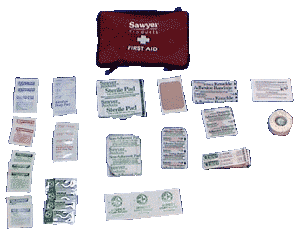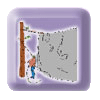The Camping First Aid kit.
This camping tip is really easy to just completely overlook. Yet, it can be the thing that makes or breaks your camping trips. You almost always need one if only for relatively minor requests. "Ken do you have any Ibuprofen?" or "I forgot my sunscreen. Do you have any?" Thus, this is an absolutely mandatory piece of camping survival gear especially if you do group camping trips or scouting outings. The more people you have out, especially kids, the greater the chance of a mishap that would require attention. A well conceived camping first aid kit could be your single most important collection of camping supplies and devices. It will be one of those things that other people borrow from you.
Basic camping first aid kit
 A good starting point for putting together a camping first aid kit is to purchase a kit that's the size you like. I sort of prefer a pouch type arrangement so it's easy to stick in a day pack should you want to venture out on a hike or two. It's likely the kit will have an array of non prescription medications, bandages, sterile wipes, anti septic etc..
However, it is probably deficient in many other ways. For example, perhaps the most common camping injury is a burn. (The kids play in the fire even though we tell them not to.) So, you'll need to add some sort of burn medication to address that contingency.
Also, most basic kits are pretty skimpy on large gauze pads or even athletic tape for taping an ankle or fashioning a splint.
A good starting point for putting together a camping first aid kit is to purchase a kit that's the size you like. I sort of prefer a pouch type arrangement so it's easy to stick in a day pack should you want to venture out on a hike or two. It's likely the kit will have an array of non prescription medications, bandages, sterile wipes, anti septic etc..
However, it is probably deficient in many other ways. For example, perhaps the most common camping injury is a burn. (The kids play in the fire even though we tell them not to.) So, you'll need to add some sort of burn medication to address that contingency.
Also, most basic kits are pretty skimpy on large gauze pads or even athletic tape for taping an ankle or fashioning a splint.
Supplements to the basic Camping First Aid Kit.
You can pretty much count on having to supplement your basic kit with other rudimentary devices and treatments. I start by transferring a little rubbing alcohol and hydrogen peroxide to some smaller containers. Also good to have, are Carmex or lip balm, eye drops or better yet an eye wash kit, and antacids (especially if the cook is in to green chiles ;-) In the tool department, toenail clippers, scissors and tweezers will prove to be handy. I also thread a needle somewhere into the wall of the inside of the pouch, just in case it becomes necessary to mine out a splinter (although, you first want to try soaking a splinter in hot salt water for 10 or 15 minutes, as sometimes, they will just pop right out with a little squeeze.) Not pictured is something I keep in my vehicle, an eye glass repair kit.
 Cayenne pepper is good for stopping bleeding and you want something that can be used for a sling just in case you need to immobilize an arm or, god forbid, fashion a tourniquet.
Cayenne pepper is good for stopping bleeding and you want something that can be used for a sling just in case you need to immobilize an arm or, god forbid, fashion a tourniquet.
Obviously, one needs to consider those you camp with, as laxatives, ammonium or allergy medicine might be appropriate for certain people.
Finally it's good to know what to do with all that stuff, so at least read the information that comes with your basic kit, preferably before you need it. If you find yourself as the coordinator for large functions, like scouts, you might want to take a first aid class or ask your local fire department or EMT's if they would do a little basic first aid training for you and even your troops. Most are happy to.
May your first aid kit be something you always have, but never need!
 Camp Tarp
Camp Tarp All Pages
All Pages Fundraising
Fundraising